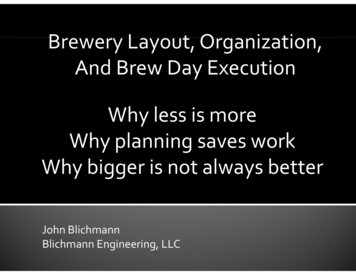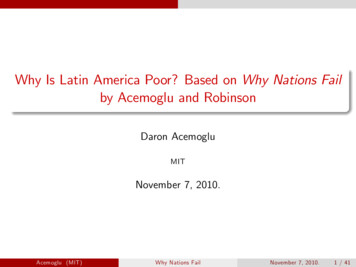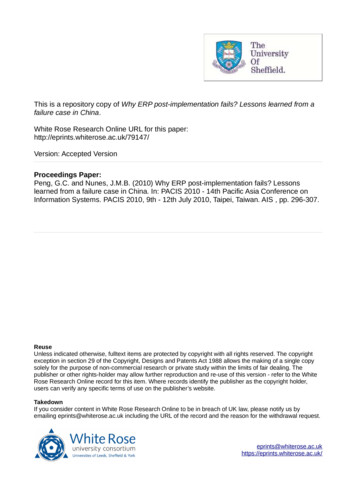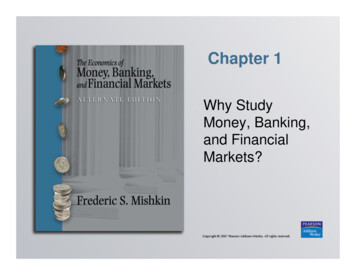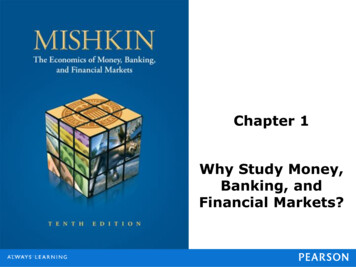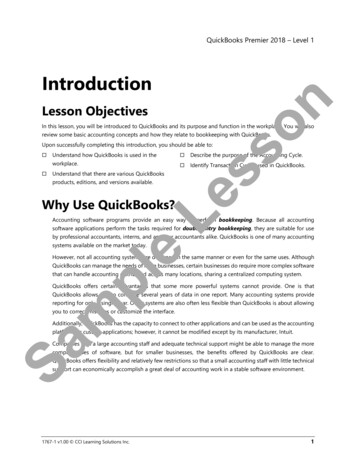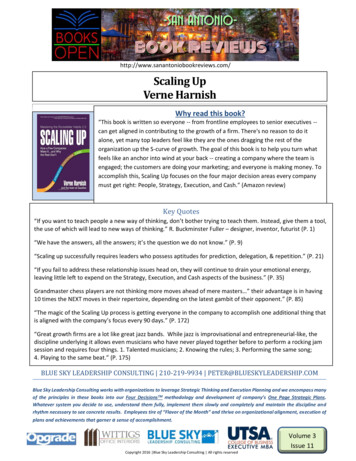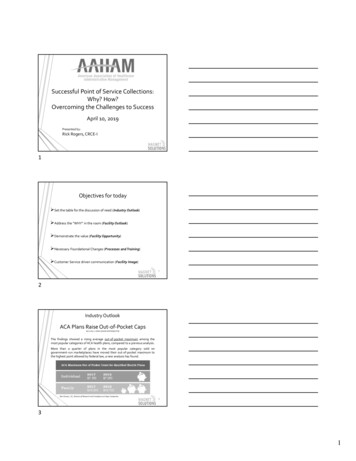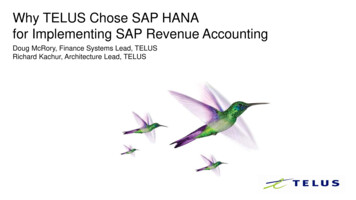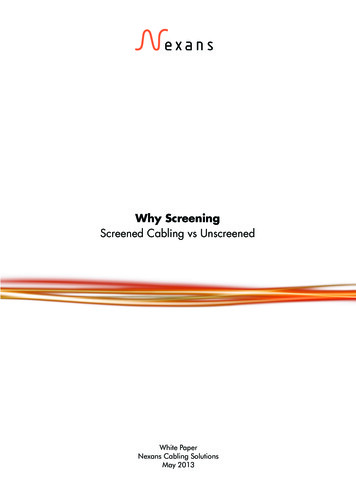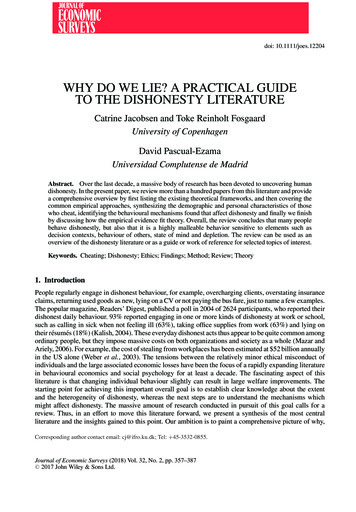
Transcription
doi: 10.1111/joes.12204WHY DO WE LIE? A PRACTICAL GUIDETO THE DISHONESTY LITERATURECatrine Jacobsen and Toke Reinholt FosgaardUniversity of CopenhagenDavid Pascual-EzamaUniversidad Complutense de MadridAbstract. Over the last decade, a massive body of research has been devoted to uncovering humandishonesty. In the present paper, we review more than a hundred papers from this literature and providea comprehensive overview by first listing the existing theoretical frameworks, and then covering thecommon empirical approaches, synthesizing the demographic and personal characteristics of thosewho cheat, identifying the behavioural mechanisms found that affect dishonesty and finally we finishby discussing how the empirical evidence fit theory. Overall, the review concludes that many peoplebehave dishonestly, but also that it is a highly malleable behavior sensitive to elements such asdecision contexts, behaviour of others, state of mind and depletion. The review can be used as anoverview of the dishonesty literature or as a guide or work of reference for selected topics of interest.Keywords. Cheating; Dishonesty; Ethics; Findings; Method; Review; Theory1. IntroductionPeople regularly engage in dishonest behaviour, for example, overcharging clients, overstating insuranceclaims, returning used goods as new, lying on a CV or not paying the bus fare, just to name a few examples.The popular magazine, Readers’ Digest, published a poll in 2004 of 2624 participants, who reported theirdishonest daily behaviour. 93% reported engaging in one or more kinds of dishonesty at work or school,such as calling in sick when not feeling ill (63%), taking office supplies from work (63%) and lying ontheir résumés (18%) (Kalish, 2004). These everyday dishonest acts thus appear to be quite common amongordinary people, but they impose massive costs on both organizations and society as a whole (Mazar andAriely, 2006). For example, the cost of stealing from workplaces has been estimated at 52 billion annuallyin the US alone (Weber et al., 2003). The tensions between the relatively minor ethical misconduct ofindividuals and the large associated economic losses have been the focus of a rapidly expanding literaturein behavioural economics and social psychology for at least a decade. The fascinating aspect of thisliterature is that changing individual behaviour slightly can result in large welfare improvements. Thestarting point for achieving this important overall goal is to establish clear knowledge about the extentand the heterogeneity of dishonesty, whereas the next steps are to understand the mechanisms whichmight affect dishonesty. The massive amount of research conducted in pursuit of this goal calls for areview. Thus, in an effort to move this literature forward, we present a synthesis of the most centralliterature and the insights gained to this point. Our ambition is to paint a comprehensive picture of why,Corresponding author contact email: cj@ifro.ku.dk; Tel: 45-3532-0855.Journal of Economic Surveys (2018) Vol. 32, No. 2, pp. 357–387 C 2017 John Wiley & Sons Ltd.
358JACOBSEN ET AL.who and when people engage in dishonest behaviour, what theoretical frameworks explain it and howto measure dishonesty in experiments. Our work is related to other reviews which share our ambition tosummarize the literature (Rosenbaum et al., 2014; Gino, 2015; Gino and Ariely, 2016). Whereas theseexisting reviews are very useful, we extend the work in several ways. First, our review is designed totarget practitioners and non-specialists, while still providing experts with an overview of how empiricalevidence fit theory and suggestions for areas where more work is needed. Second, we apply a structurethat enables the reader to gain a quick understanding of the most important theories on the subject,methods used to investigate it and empirical evidence capturing characteristics of the common cheatersand the most important behavioural mechanisms affecting (dis)honesty. Finally, we link evidence backto theory. Third, our focus is broad and covers more sub-areas, findings and mechanisms than previousreviews.To construct the review, we have assembled more than 100 experimental papers from both psychologyand economics. We limit our selection in three ways. First, we focus on individual decisions to actdishonestly and, hence, we do not consider cheating as a group decision. However, the studies includeddo reflect social interactions or the presence of other people, but the key selection point is that the eventualchoices and decision to cheat or lie rest with the individual in the experiment. Second, the scope is limitedto small-scale dishonesty so that it is distinct from taxation fraud studies and the literature on corruption.While these subjects are incredibly interesting, they have been thoroughly studied, which is why we arguethat they deserve the attention of individual reviews of their own. Finally, the papers included had toencompass an experimental approach.The review is structured to provide a useful overview and a practical guide, which can be used as awork of reference. The paper is organized as follows: In Section 2, we present the theory proposed inthe literature on why people cheat, while Section 3 discusses the diverse methodological tasks employedto quantify and study dishonesty. Section 4 focuses on the demographic and personal characteristics ofcheaters. Section 5 surveys the mechanisms which have been found to affect dishonesty, while Section 6Figure 1. Review structure and questions addressed in this review.Journal of Economic Surveys (2018) Vol. 32, No. 2, pp. 357–387 C 2017 John Wiley & Sons Ltd.
WHY DO WE LIE?359deals with the explicit and implicit tools that promote honesty. Finally, Section 7 sums up the empiricalfindings in relation to the theory in the literature and Section 8 concludes. Figure 1 provides a visualoverview of the review structure.2. Theory: Why Do We Lie?In this section, we briefly focus on six main theories that have been developed to explain why peopleengage in unethical behaviour. Many other theories exist and, in general, the literature would benefit froma thorough review of all the theories in this field. However, for the sake of limiting this review, we focuson a few underlying drivers which have been identified by researchers in the field.2.1 An Economic Model of Crime and DishonestyIn 1968, Gary Becker recognized that the act of committing a crime could in fact be explained by economictheory. He brought dishonest actions into a rational economic theoretical framework based on expectedutility theory. The decision maker faces a dilemma between the expected costs of punishment and thebenefits related to committing a given crime. For example, if the expected costs of parking illegally inthe city centre were lower than the gain for say meeting a deadline or getting to a meeting on time,Becker argued that a rational agent should opt for parking the car illegally closer to his destinationin order to get to the meeting in time (Becker, 1968). Therefore, a crime will only be committed ifthe expected utility derived from it exceeds the utility from legal activity that can be attained with thesame resources. With this theory comes also the argument that the way to fight crime is to either increasethe costs connected with committing the crime, such as more severe punishment, or increase the likelihoodof getting caught through means such as surveillance or detective work.More recent behavioural economists have tested this model and have explored whether decisions to actdishonestly follow this theoretical prediction. As pointed out by Becker (1968), economically speaking,it is not surprising that people engage in dishonest actions and cheat or lie to increase personal gain. It is,however, quite puzzling that not everyone cheats when they can get away with it and punishment is lowor non-existing and that people rarely cheat as much as they possibly can to maximize their gains.2.2 Moral Balance ModelIn contrast to the economic approach taken by Becker (1968), the psychologist, Nisan (1991), formulatedthe moral balance model. He argues that moral behaviour is the result of a moral balance score of formergood and bad behaviour, which is taken into account when people make moral choices. He argues thatmoral identity is important to people and that moral choices are, therefore, not limited to a cost-benefitapproach. Instead, people compare their current moral state (which is based on the moral activities theyhave performed within a given period) to that of a personal standard (or lower bound), which they willnot surpass when they make a choice. Instead of always aspiring to an ideal morality, people followa limited morality thesis, which allows them to deviate from what they know to be morally correctbehaviour as long as an overall balance is kept over time. Furthermore, Nisan (1991) argues that thisbalanced identity is made up of both self-serving behaviour and morally compliant behaviour, so thatif a person has recently done something good, they might subsequently choose to be self-serving ratherthan being moral once more since the balance is in ‘surplus’. This theory makes no predictions abouthow individuals will or should act, it merely states that behaviour is a product of the personal balancescore.Journal of Economic Surveys (2018) Vol. 32, No. 2, pp. 357–387 C 2017 John Wiley & Sons Ltd.
360JACOBSEN ET AL.2.3 Self-Concept Maintenance TheoryClosely related to the moral balance model, Mazar et al. (2008) argue that it is self-concepts and identitythat guide people’s choices. People will act dishonestly if they can do so without having to update theirself-image of being good and honest people. This phenomenon often results in some cheating whenthe opportunity presents itself, but rarely maximum cheating behaviour, even though it would result inhigher financial gains. To test whether self-concept updating occurred after committing a dishonest act,the authors asked people to estimate how well they would perform on a similar task in which no cheatingwas possible. They were also asked how moral they felt that day compared to the day before. The resultsshowed that people lowered their performance estimates, which indicated an awareness of the dishonestact they had just committed, but they did not update their self-image and felt just as moral and good asthey had the day before. As with the moral balance model, self-concept maintenance theory hypothesizesthat people will only act immorally within a certain limited framework (i.e. not surpassing certain moralboundaries), and that the more malleable the category of the moral choice, the easier it will be for themto justify self-serving behaviour.2.4 Self-Serving JustificationsOne factor that influences the decision to act dishonestly is the internal process that justifies an individual’sbehaviour. A justification strategy may appear both before and after the decision to behave unethically.Pre-violation justifications allow us to excuse certain behaviour in advance without threatening the moralself. Post-violation justifications compensate the threat to the moral self by alleviating the experienceddiscomfort or dissonance related to the transgression (Shalvi et al., 2015). Shalvi et al. (2012) evensuggest that people will not behave dishonestly if they lack any justification for doing so.2.5 Moral DisengagementIn line with Nisan’s theory of moral balance and his limited morality thesis (Nisan, 1991), Shu et al. (2011)examine how people are able to deviate from morally correct behaviour while not feeling guilty. They arguethat dishonest behaviour (both hypothetical and actual) leads to the individual experiencing increasedmoral disengagement. Moral disengagement means that people seem to be able to excuse themselvesfrom the moral rules that they apply to other people (what Nisan refers to as limited morality). Thisstrategy makes it easier to commit an immoral act and reduces the experienced dissonance. Importantly,the authors argue that moral disengagement does not apply to the participants’ honest behaviour or thedishonest behaviour of others, but only to the participants’ misconduct.2.6 Bounded Ethicality and Ethical BlindnessWhereas many people are aware of the ethical norms that govern certain choices and, hence, decide todeliberately break the norms or not, another possibility is that people’s awareness is bounded (Chughet al., 2005). The theory of bounded ethicality asserts that some people are unaware of the ethical normsand, therefore, behave dishonestly unconsciously. Such people are unaware of norms, or simply do notreflect on their behaviour, even though it goes against their moral compass (Bazerman and Moore, 2012).When unaware, these people do not have any concerns or experience dissonance. Gino et al. (2010a)studied motivated ethical blindness as a decision strategy that promotes unethical behaviour. Specifically,people generally have a tendency to ignore unethical actions when they process information if it is in theirself-interest.Journal of Economic Surveys (2018) Vol. 32, No. 2, pp. 357–387 C 2017 John Wiley & Sons Ltd.
WHY DO WE LIE?3613. Method: How Do We Study Dishonesty?Dishonest behaviour can be difficult to observe either because it involves illegal activities, which aredifficult to replicate in an experimental set-up, or because people generally try to conceal such behaviourwhen attempting to get away with it. For this reason, it is particularly important not to solely rely onself-reporting measures and, therefore, great effort has been devoted to developing different tasks toreveal dis(honest) preferences. In the following sections, we discuss population inferred cheating tasks,individually inferred cheating tasks, social tasks, and field tasks used in the literature.3.1 Population Inferred Cheating TasksBy population inferred tasks we refer to tasks for which only statistics can be used to determine whethercheating has occurred or not. This means that dishonest behaviour can only be identified at an aggregatelevel, and it either requires a known statistical distribution of expected outcomes or a comparable controlgroup, where behaviour is known. Examples of population inferred cheating tasks with a known expecteddistributional outcome include throwing a die (or multiple dice) or flipping a coin in private, wherethe experimenter does not know the actual outcome. In the experimental economics research, deceivingexperimental subjects is methodologically unacceptable, which means that the researcher cannot lie aboutthe details of the experiment, for example, knowing the true outcome of a task after having informed theparticipant that this is not the case. Population-based tasks are, therefore, much valued and have oftenbeen applied in the experimental economics literature since it is easy to avoid the deception of subjects.The experimenter can reliably set up a choice situation where it is perfectly clear that it is not possible toverify actual behaviour. Therefore, in the behavioural economics literature, many have chosen to use thistask, even though the experimenter cannot determine any details about the cheating, for example, whohas cheated and to what extent; he can only statistically infer that cheating has occurred.A widely known version of such a task is the die-in-a-cup paradigm, developed by Fischbacher andFöllmi-Heusi (2013), in which a subject rolls a die in a cup that has been covered so there is only a tinyhole through which the outcome can be observed. This paradigm ensures that the individual subject isperfectly sure that no one apart from him can see the outcome, which gives him complete freedom tocheat and claim a higher outcome without any risk of being detected. Other studies which have used thisparadigm include (Mazar and Zhong, 2010; Shalvi et al., 2011a,b, 2012; Fosgaard, 2013; Hao and Houser,2013; Hilbig and Hessler, 2013; Shalvi and Leiser, 2013; Utikal and Fischbacher, 2013; Jacobsen andPiovesan, 2016). Similarly, a simple coin toss (Bucciol and Piovesan, 2011) also allows the experimenterto statistically determine the data distribution with a 50/50 distribution of the two possible outcomes.However, a drawback of this set up compared to the die-in-a-cup task is that cheating is dichotomous. Withone coin flip, you are either honest or not, and there is no way to cheat more or less, whereas reportinga die outcome is scalar. This issue can be resolved by allowing multiple coin tosses as seen in the paperby Nogami and Yoshida (2013). The coin toss has been used in several studies including (Houser et al.,2012; Shalvi, 2012; Bryan et al., 2013; Fosgaard et al., 2013; Nogami and Yoshida, 2013; Abeler et al.,2014; Cohn et al., 2014; Shalvi and De Dreu, 2014; Shaw et al., 2014; Pascual-Ezama et al., 2015b).The second approach used to develop tasks with population inferred cheating is to infer the level ofcheating by comparing the behaviour of a treatment group with a control group. This approach is widelyused in medical research and is known as randomized controlled trials, where experimental subjects arerandomly allocated to one of two groups. The difference between the groups is that the control groupserves as a baseline as actual behaviour and stated behaviour can be verified, whereas no verificationof behaviour occurs in the second group, which opens up for misreporting. This approach allows theauthors to determine whether reported behaviour differs in the group without verification and whetherpeople on an aggregate level in the group respond differently to different treatments studied. Such tasksinclude standardized tests (e.g. solving math tasks, basic trivia and/or word tasks) or repeated tasks of aJournal of Economic Surveys (2018) Vol. 32, No. 2, pp. 357–387 C 2017 John Wiley & Sons Ltd.
362JACOBSEN ET AL.Figure 2. (A): illustrates the matrix task. During this task participants are supposed to find the two numbersthat equals ten and indicate whether they found it. Several matrices have to be solved within a certain timelimit. Introduced by Mazar, Amir, and Ariely (2008). (B): illustrates the perceptual dot-task, whereparticipants are asked to indicate whether the left or right side of the screen contains most red dots. They arepaid more when they indicate that the right side contains more. The task varies in difficulty level. Firstintroduced by Mazar & Ariely (2006), and first published by Mazar & Zhong (2010). [Colour figure can beviewed at wileyonlinelibrary.com]simple nature, also referred to as real-effort tasks1 (such as counting coins). An example of a widely usedmath-based matrix task is presented in Figure 2(A) (Mazar et al., 2008).3.2 Individually Inferred Cheating TasksIndividually inferred cheating tasks are situations which make it possible to detect whether people havecheated on an individual level. This is possible if the actual result or performance of a certain taskcan be linked to the participant’s stated answers or performance. This is often done by separating theperformance task and the reporting mechanics so it appears as though no detection is possible. The tasksdesigned in order to detect cheating on an individual level, thus, seek to maintain privacy during the task.In social psychology, the deception of experimental subjects is methodologically acceptable. In fact, it isrecognized that in order to study certain effects, deception might be necessary. For this reason, individualcheating tasks are more often adopted in the social psychology literature.There are several ways of detecting whether an individual is cheating, but a common method is toinclude a subtle identifier in the task, which makes it possible to compare actual performance and statedperformance ex post. Examples include variations in details of a task, such as a specific mark on theparticipant’s report and task sheets or even using
360 JACOBSEN ET AL. 2.3 Self-Concept Maintenance Theory Closely related to the moral balance model, Mazar et al. (2008) argue that it is self-concepts and identity that guide people’s choices. People will act dis

